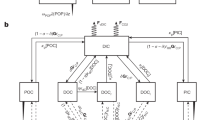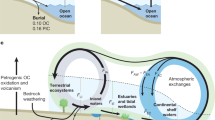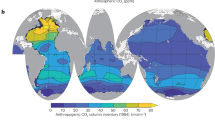Abstract
Measurements of atmospheric CO2 concentration provide a tight constraint on the sum of the land and ocean sinks. This constraint has been combined with estimates of ocean carbon flux and riverine transport of carbon from land to oceans to isolate the land sink. Uncertainties in the ocean and river fluxes therefore translate into uncertainties in the land sink. Here, we introduce a heat-based constraint on the latitudinal distribution of ocean and river carbon fluxes, and reassess the partition between ocean, river and land in the tropics, and in the southern and northern extra-tropics. We show that the ocean overturning circulation and biological pump tightly link the ocean transports of heat and carbon between hemispheres. Using this coupling between heat and carbon, we derive ocean and river carbon fluxes compatible with observational constraints on heat transport. This heat-based constraint requires a 20–100% stronger ocean and river carbon transport from the Northern Hemisphere to the Southern Hemisphere than existing estimates, and supports an upward revision of the global riverine carbon flux from 0.45 to 0.78 PgC yr−1. These systematic biases in existing ocean/river carbon fluxes redistribute up to 40% of the carbon sink between northern, tropical and southern land ecosystems. As a consequence, the magnitude of both the southern land source and the northern land sink may have to be substantially reduced.
This is a preview of subscription content, access via your institution
Access options
Access Nature and 54 other Nature Portfolio journals
Get Nature+, our best-value online-access subscription
$29.99 / 30 days
cancel any time
Subscribe to this journal
Receive 12 print issues and online access
$259.00 per year
only $21.58 per issue
Buy this article
- Purchase on Springer Link
- Instant access to full article PDF
Prices may be subject to local taxes which are calculated during checkout






Similar content being viewed by others
References
Tans, P. P., Fung, I. Y. & Takahashi, T. Observational contraints on the global atmospheric CO2 budget. Science 247, 1431–1438 (1990).
Peylin, P. et al. Global atmospheric carbon budget: results from an ensemble of atmospheric CO2 inversions. Biogeosciences 10, 6699–6720 (2013).
Pan, Y. et al. A large and persistent carbon sink in the world’s forests. Science 333, 988–993 (2011).
Sarmiento, J. L. et al. Trends and regional distributions of land and ocean carbon sinks. Biogeosciences 7, 2351–2367 (2010).
Keeling, C. D., Piper, S. C., Whorf, T. P. & Keeling, R. F. Evolution of natural and anthropogenic fluxes of atmospheric CO2 from 1957 to 2003. Tellus B 63, 1–22 (2011).
Schimel, D., Stephens, B. B. & Fisher, J. B. Effect of increasing CO2 on the terrestrial carbon cycle. Proc. Natl Acad. Sci. USA 112, 436–441 (2015).
Graven, H. D. et al. Enhanced seasonal exchange of CO2 by northern ecosystems since 1960. Science 341, 1085–1089 (2013).
Forkel, M. et al. Enhanced seasonal CO2 exchange caused by amplified plant productivity in northern ecosystems. Science 351, 696–699 (2016).
Quéré, C. L. et al. Global carbon budget 2016. Earth Syst. Sci. Data 8, 605–649 (2016).
Bousquet, P. et al. Regional changes in carbon dioxide fluxes of land and oceans since 1980. Science 290, 1342–1346 (2000).
Stephens, B. B. et al. Weak northern and strong tropical land carbon uptake from vertical profiles of atmospheric CO2. Science 316, 1732–1735 (2007).
Andres, R. J. et al. A synthesis of carbon dioxide emissions from fossil-fuel combustion. Biogeosciences 9, 1845–1871 (2012).
Denning, A. S., Fung, I. Y. & Randall, D. Latitudinal gradient of atmospheric CO2 due to seasonal exchange with land biota. Nature 376, 240–243 (1995).
Khatiwala, S., Primeau, F. & Hall, T. Reconstruction of the history of anthropogenic CO2 concentrations in the ocean. Nature 462, 346–349 (2009).
Broecker, W. S. & Peng, T.-H. Interhemispheric transport of carbon dioxide by ocean circulation. Nature 356, 587–589 (1992).
Sarmiento, J. L. & Sundquist, E. T. Revised budget for the oceanic uptake of anthropogenic carbon dioxide. Nature 356, 589–593 (1992).
Aumont, O. et al. Riverine-driven interhemispheric transport of carbon. Glob. Biogeochem. Cycles 15, 393–405 (2001).
Keeling, C. D., Piper, S. C. & Heimann, M. in Aspects of Climate Variability in the Pacific and the Western Americas (ed. Peterson, D. H.) 305–363 (American Geophysical Union, Washington, DC, 1989).
Gurney, K. R. et al. High resolution fossil fuel combustion CO2 emission fluxes for the United States. Environ. Sci. Technol. 43, 5535–5541 (2009).
Olivier, J. G. J., Janssens-Maenhout, G., Muntean, M. & Peters, J. A. H. W. Trends in Global CO 2 Emissions: 2016 Report (PBL Netherlands Environmental Assessment Agency, 2016); http://www.pbl.nl/en/publications/trends-in-global-co2-emissions-2016-report
Steinkamp, K. & Gruber, N. A joint atmosphere–ocean inversion for the estimation of seasonal carbon sources and sinks. Glob. Biogeochem. Cycles 27, 732–745 (2013).
Houghton, R. A. Why are estimates of the terrestrial carbon balance so different? Glob. Change Biol. 9, 500–509 (2003).
Houghton, R. A. et al. Carbon emissions from land use and land-cover change. Biogeosciences 9, 5125–5142 (2012).
Brewer, P. G., Goyet, C. & Dyrssen, D. Carbon dioxide transport by ocean currents at 25°N latitude in the Atlantic Ocean. Science 246, 477–479 (1989).
Keeling, R. F. & Peng, T.-H. Transport of heat, CO2 and O2 by the Atlantic's thermohaline circulation. Philos Trans. R. Soc. Lond. B 348, 133–142 (1995).
Large, W. G. & Yeager, S. G. The global climatology of an interannually varying air–sea flux data set. Clim. Dyn. 33, 341–364 (2009).
Resplandy, L. et al. Constraints on oceanic meridional heat transport from combined measurements of oxygen and carbon. Clim. Dyn. 47, 3335 (2016).
Ganachaud, A. & Wunsch, C. Large-scale ocean heat and freshwater transports during the World Ocean Circulation Experiment. J. Clim. 16, 696–705 (2003).
Schlitzer, R. in Inverse Methods in Global Biogeochemical Cycles (eds. Kasibhatla, P. et al.) 107–124 (American Geophysical Union, Washington, DC, 2000); https://doi.org/10.1029/GM114p0107
Henson, S. A. et al. Rapid emergence of climate change in environmental drivers of marine ecosystems. Nat. Commun. 8, 14682 (2017).
Siegel, D. A. et al. Global assessment of ocean carbon export by combining satellite observations and food-web models. Glob. Biogeochem. Cycles 28, 181–196 (2014).
DeVries, T. & Weber, T. The export and fate of organic matter in the ocean: new constraints from combining satellite and oceanographic tracer observations. Glob. Biogeochem. Cycles 31, 2016GB005551 (2017).
Yeager, S. & Danabasoglu, G. Sensitivity of Atlantic meridional overturning circulation variability to parameterized Nordic Sea overflows in CCSM4. J. Clim. 25, 2077–2103 (2011).
Wang, C., Zhang, L., Lee, S.-K., Wu, L. & Mechoso, C. R. A global perspective on CMIP5 climate model biases. Nat. Clim. Change 4, 201–205 (2014).
Ma, X. et al. Western boundary currents regulated by interaction between ocean eddies and the atmosphere. Nature 535, 533–537 (2016).
Doney, S. C. et al. Evaluating global ocean carbon models: the importance of realistic physics. Glob. Biogeochem. Cycles 18, GB3017 (2004).
Mikaloff Fletcher, S. E. et al. Inverse estimates of the oceanic sources and sinks of natural CO2 and the implied oceanic carbon transport. Glob. Biogeochem. Cycles 21, GB1010 (2007).
Jacobson, A. R., Mikaloff Fletcher, S. E., Gruber, N., Sarmiento, J. L. & Gloor, M. A joint atmosphere–ocean inversion for surface fluxes of carbon dioxide: 1. Methods and global-scale fluxes. Glob. Biogeochem. Cycles 21, GB1019 (2007).
Gerber, M. & Joos, F. Carbon sources and sinks from an ensemble Kalman filter ocean data assimilation. Glob. Biogeochem. Cycles 24, GB3004 (2010).
DeVries, T. The oceanic anthropogenic CO2 sink: storage, air–sea fluxes, and transports over the industrial era. Glob. Biogeochem. Cycles 28, 631–647 (2014).
Gruber, N. et al. Oceanic sources, sinks, and transport of atmospheric CO2. Glob. Biogeochem. Cycles 23, GB1005 (2009).
Sarmiento, J. L. et al. Sea–air CO2 fluxes and carbon transport: a comparison of three ocean general circulation models. Glob. Biogeochem. Cycles 14, 1267–1281 (2000).
Murnane, R. J., Sarmiento, J. L. & Le Quéré, C. Spatial distribution of air–sea CO2 fluxes and the interhemispheric transport of carbon by the oceans. Glob. Biogeochem. Cycles 13, 287–305 (1999).
Rödenbeck, C. et al. Global surface-ocean pCO2 and sea-air CO2 flux variability from an observation-driven ocean mixed-layer scheme. Ocean Sci. 9, 193–216 (2013).
Takahashi, T. et al. Climatological mean and decadal change in surface ocean pCO2, and net sea-air CO2 flux over the global oceans. Deep Sea Res. Part II Top. Stud. Oceanogr. 56, 554–577 (2009).
Landschützer, P., Gruber, N., Bakker, D. C. E. & Schuster, U. Recent variability of the global ocean carbon sink. Glob. Biogeochem. Cycles 28, 927–949 (2014).
Wanninkhof, R. et al. Global ocean carbon uptake: magnitude, variability and trends. Biogeosciences 10, 1983–2000 (2013).
Khatiwala, S. et al. Global ocean storage of anthropogenic carbon. Biogeosciences 10, 2169–2191 (2013).
Rödenbeck, C., Houweling, S., Gloor, M. & Heimann, M. CO2 flux history 1982–2001 inferred from atmospheric data using a global inversion of atmospheric transport. Atmos. Chem. Phys. 3, 1919–1964 (2003).
Grace, J., Mitchard, E. & Gloor, E. Perturbations in the carbon budget of the tropics. Glob. Change Biol. 20, 3238–3255 (2014).
Conway, T. J. & Tans, P. P. Development of the CO2 latitude gradient in recent decades. Glob. Biogeochem. Cycles 13, 821–826 (1999).
Fan, S. et al. A large terrestrial carbon sink in North America implied by atmospheric and oceanic carbon dioxide data and models. Science 282, 442–446 (1998).
Regnier, P. et al. Anthropogenic perturbation of the carbon fluxes from land to ocean. Nat. Geosci. 6, 597–607 (2013).
Bauer, J. E. et al. The changing carbon cycle of the coastal ocean. Nature 504, 61–70 (2013).
Clark, E. A., Sheffield, J., van Vliet, M. T. H., Nijssen, B. & Lettenmaier, D. P. Continental runoff into the oceans (1950–2008). J. Hydrometeorol. 16, 1502–1520 (2015).
Bianchi, T. S. et al. Enhanced transfer of terrestrially derived carbon to the atmosphere in a flooding event. Geophys. Res. Lett. 40, 116–122 (2013).
Kwon, E. Y. et al. Global estimate of submarine groundwater discharge based on an observationally constrained radium isotope model. Geophys. Res. Lett. 41, 8438–8444 (2014).
Le Gland, G., Mémery, L., Aumont, O. & Resplandy, L. Improving the inverse modeling of a trace isotope: how precisely can radium-228 fluxes toward the ocean and submarine groundwater discharge be estimated? Biogeosciences 14, 3171–3189 (2017).
Woolf, D. K., Land, P. E., Shutler, J. D., Goddijn-Murphy, L. M. & Donlon, C. J. On the calculation of air-sea fluxes of CO2 in the presence of temperature and salinity gradients: air-sea CO2 fluxes. J. Geophys. Res. Oceans 121, 1229–1248 (2016).
Rödenbeck, C. et al. Data-based estimates of the ocean carbon sink variability – first results of the Surface Ocean pCO2 Mapping intercomparison (SOCOM). Biogeosciences 12, 7251–7278 (2015).
Schuster, U. et al. An assessment of the Atlantic and Arctic sea–air CO2 fluxes, 1990–2009. Biogeosciences 10, 607–627 (2013).
Dunne, J. P. et al. GFDLas ESM2 Global Coupled Climate-Carbon Earth System Models. Part I: physical formulation and baseline simulation characteristics. J. Clim. 25, 6646–6665 (2012).
Dunne, J. P. et al. GFDLas ESM2 Global Coupled Climate-Carbon Earth System Models. Part II: carbon system formulation and baseline simulation characteristics. J. Clim. 26, 2247–2267 (2013).
Séférian, R., Iudicone, D., Bopp, L., Roy, T. & Madec, G. Water mass analysis of effect of climate change on air–sea CO2 fluxes: the southern ocean. J. Clim. 25, 3894–3908 (2012).
Ilyina, T. et al. Global ocean biogeochemistry model HAMOCC: model architecture and performance as component of the MPI-Earth system model in different CMIP5 experimental realizations. J. Adv. Model. Earth Syst. 5, 287–315 (2013).
Tjiputra, J. F. et al. Evaluation of the carbon cycle components in the Norwegian Earth System Model (NorESM). Geosci. Model Dev. 6, 301–325 (2013).
Long, M. C., Deutsch, C. & Ito, T. Finding forced trends in oceanic oxygen. Glob. Biogeochem. Cycles 30, 2015GB005310 (2016).
Kay, J. E. et al. The Community Earth System Model (CESM) Large Ensemble Project: a community resource for studying climate change in the presence of internal climate variability. Bull. Am. Meteorol. Soc. 96, 1333–1349 (2014).
Aumont, O., Ethé, C., Tagliabue, A., Bopp, L. & Gehlen, M. PISCES-v2: an ocean biogeochemical model for carbon and ecosystem studies. Geosci. Model Dev. 8, 2465–2513 (2015).
Hobbs, W., Palmer, M. D. & Monselesan, D. An energy conservation analysis of ocean drift in the CMIP5 global coupled models. J. Clim. 29, 1639–1653 (2015).
Séférian, R. et al. Inconsistent strategies to spin up models in CMIP5: implications for ocean biogeochemical model performance assessment. Geosci. Model Dev. 9, 1827–1851 (2016).
Lundberg, L. & Haugan, P. M. A Nordic seas–Arctic Ocean carbon budget from volume flows and inorganic carbon data. Glob. Biogeochem. Cycles 10, 493–510 (1996).
Macdonald, A. M., Baringer, M. O., Wanninkhof, R., Lee, K. & Wallace, D. W. R. A 1998–1992 comparison of inorganic carbon and its transport across 24.5°N in the Atlantic. Deep Sea Res. Part II Top. Stud. Oceanogr. 50, 3041–3064 (2003).
Holfort, J., Johnson, K. M., Schneider, B., Siedler, G. & Wallace, D. W. R. Meridional transport of dissolved inorganic carbon in the South Atlantic Ocean. Glob. Biogeochem. Cycles 12, 479–499 (1998).
Álvarez, M., Ríos, A. F., Pérez, F. F., Bryden, H. L. & Rosón, G. Transports and budgets of total inorganic carbon in the subpolar and temperate North Atlantic. Glob. Biogeochem. Cycles 17, 1002 (2003).
Johns, W. E. et al. Continuous, array-based estimates of Atlantic Ocean heat transport at 26.5°N. J. Clim. 24, 2429–2449 (2011).
Acknowledgements
L.R. was granted support by the Climate Program Office of the National Oceanic and Atmospheric Administration grant NA13OAR4310219. S.K. was supported by US National Science Foundation (NSF) grant OCE 10-60804. K.B.R. was supported by NASA award NNX14AL85G. N.C.A.R. is sponsored by the NSF. The authors also thank the groups developing MOM, MITgcm, NEMO and CMIP5 models for providing their model results.
Author information
Authors and Affiliations
Contributions
L.R. directed the analysis of the several data sets used here and shared responsibility for writing the manuscript. R.F.K. and B.B.S. shared responsibility for writing the manuscript. C.R. computed the land sinks. L.B., M.C.L. and K.B.R. provided model results. All authors contributed to the final version of the manuscript.
Corresponding author
Ethics declarations
Competing interests
The authors declare no competing interests.
Additional information
Publisher’s note: Springer Nature remains neutral with regard to jurisdictional claims in published maps and institutional affiliations.
Supplementary information
Supplementary Information
Supplementary material
Rights and permissions
About this article
Cite this article
Resplandy, L., Keeling, R.F., Rödenbeck, C. et al. Revision of global carbon fluxes based on a reassessment of oceanic and riverine carbon transport. Nature Geosci 11, 504–509 (2018). https://doi.org/10.1038/s41561-018-0151-3
Received:
Accepted:
Published:
Issue Date:
DOI: https://doi.org/10.1038/s41561-018-0151-3
This article is cited by
-
Trends and variability in the ocean carbon sink
Nature Reviews Earth & Environment (2023)
-
River ecosystem metabolism and carbon biogeochemistry in a changing world
Nature (2023)
-
The land-to-ocean loops of the global carbon cycle
Nature (2022)
-
Evaluation of earth system model and atmospheric inversion using total column CO2 observations from GOSAT and OCO-2
Progress in Earth and Planetary Science (2021)
-
Circulation-driven variability of Atlantic anthropogenic carbon transports and uptake
Nature Geoscience (2021)



